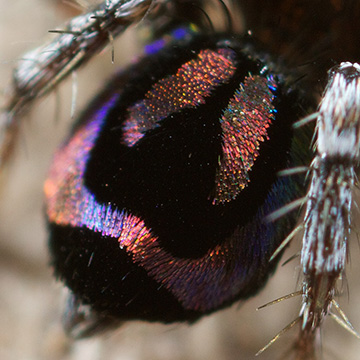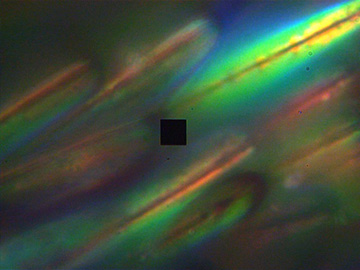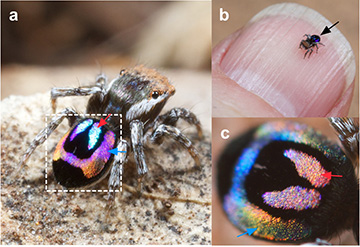Males of the Australian peacock spider, a mere 2.5 mm long, achieve a spectactular courtship display via structural-color patches on their abdomens. [Image: Jürgen C. Otto, coauthor] [Enlarge image]
A multinational research team has dug into the source of the iridescent colors of peacock spiders, a group of 2.5-mm-long arachnids whose males rely on a glimmering abdominal display to attract mates (Nat. Commun., doi: 10.1038/s41467-017-02451-x).
Using a combination of light and electron microscopy, hyperspectral imaging, numerical modeling and other techniques, the researchers established that the spiders’ spectacular display arises from the scattering of light off of micrometer-scale, airfoil-shaped scales decorated with tiny structures that operate as convex, nanoscale diffraction gratings. The scientists also could partly duplicate the scales’ effect in a 3-D-nanoprinted prototype—a finding, they suggest, that could be leveraged in “novel, miniature light-dispersive components” and micro-spectrometers.
Courtship display

Abdomen of Peacock spider Maratus robinsoni. [Image: Jürgen C. Otto, coauthor]
The males of two species of diminutive Australian arachnids studied in the work, Maratus robinsoni and M. chrysomelas, feature black abdomens painted with intricate structural-color patches that vary from red to green to violet depending on the viewing angle. The male spiders, in the discreet words of the paper, “raise and wiggle their abdomens” in the direction of potential mates, who thereby benefit from a courtship display spanning the entire visible spectrum. (What happens next is up to the spiders.)
A team led by researchers at the University of Akron, USA, along with colleagues at universities in the United States, Belgium and the Netherlands, wanted to explore the microstructures that made these displays possible—and to see if those structures might be harnessed for new optical designs. To get started, Bor-Kai Hsiung, then an Akron grad student and now a postdoc at the University of California’s Scripps Institution in San Diego, began by obtaining specimens of the tiny spiders from collectors in Australia, including coauthor Jürgen Otto.
Airfoil-shaped scales
Hsiung, with colleagues Matthew Shawkey and Todd Blackledge at Akron, then used scanning and transmission electron microscopy, hyperspectral imaging and scattering interferometry to get a close look at what was behind the critters’ structural coloration. The electron microscopy revealed that the spiders’ iridescent patches consisted of a field of tiny, aligned airfoil-shaped scales, on a ground of more randomly arranged, brushlike black scales.

A light micrograph of rainbow-patterned M. robinsoni scales. Sides of the black square are 4 microns long. [Image: Bor-Kai Hsiung, co-author]
Decorating the edges of the airfoil-shaped scales were grating structures around 500 nm deep and spaced at periods ranging from 500 to 800 nm. And the team found, in analyzing the optical output of the airfoil scales, that the structures dispersed light spanning the entire visible spectrum over a small angle. That suggested that the light show constituting the spiders’ courtship routine might come from a combination of the scales’ unusual airfoil shape and the diffraction-grating-like structures decorating them.
Printing a prototype
To test that hypothesis, the researchers developed a variety of grating designs, including a flat grating, an angular prism grating and an airfoil-shaped grating, as well as an airfoil-shaped design without nanoscale grating structures. The team then produced prototypes of the designs with a two-photon laser nanolithography system from the German firm Nanoscribe.
Hyperspectral-imaging and scattering experiments with the resulting 3-D-nanoprinted models showed that only the airfoil-shaped model that included the grating structure could reproduce the colors of the spiders’ natural scales. Simulated reflectance spectra from finite-element optical modeling further confirmed that the airfoil-shaped gratings provided an optimal match with the spiders’ natural display.
The researchers believe that this natural model, coupled with further optimization via computer-aided optical design, could “allow engineers to design and develop optical devices, especially spectrometers, with at least 50 percent smaller length scale” than conventional techniques allow. Such miniaturized spectrometers, they suggest, could prove useful in settings where “fine-scale spectral resolution is required in a very small package,” such as space missions and on-site chemical detection.
In addition to scientists from the University of Akron, the work included contribution from researchers at Scripps, the University of Nebraska, and the California Institute of Technology, USA; the University of Ghent, Belgium; and the University of Groningen, Netherlands.

